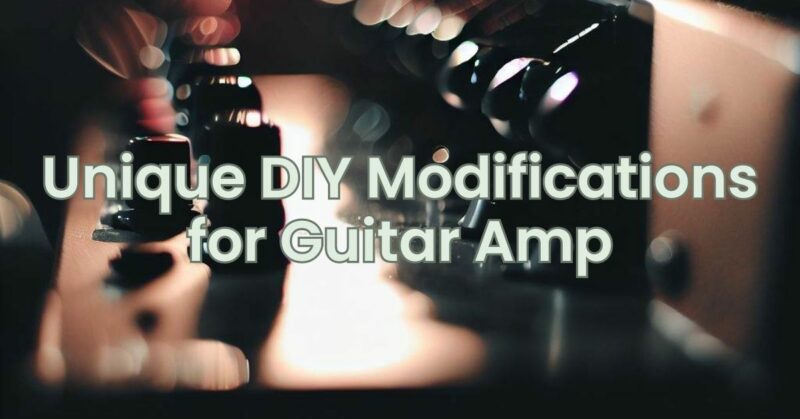If you’re a guitar player looking to explore new tonal possibilities and personalize your sound, DIY modifications for your guitar amp can be a rewarding and exciting endeavor. Making unique modifications to your amp can unlock hidden potential, enhance specific characteristics, and add a touch of individuality to your tone. In this article, we will delve into some unique DIY modifications for your guitar amp that you can explore to unleash your creativity and take your sound to new heights.
- Tube Swapping: One of the simplest yet impactful modifications you can make is to swap the tubes in your amplifier. Different tubes can have distinct tonal characteristics and response, allowing you to tailor your amp’s sound to your preferences. For example, replacing the preamp tubes with ones known for warmth and smoothness can add a vintage touch to your tone, while swapping power tubes can provide more headroom or a different level of compression. Research and experiment with different tube options to find the ones that best suit your desired sound.
- Speaker Replacement: Upgrading the speaker in your amp can dramatically alter its sonic characteristics. Different speakers have varying frequency responses, sensitivity levels, and tonal qualities. Consider the tonal characteristics you desire, such as enhanced lows, smoother highs, or increased clarity, and research speakers that align with those goals. Swapping the stock speaker with a higher-quality speaker can result in improved articulation, tighter bass response, and a more balanced overall tone.
- Tone Stack Modifications: The tone stack, consisting of bass, middle, and treble controls, plays a crucial role in shaping your amp’s sound. Modifying the values of the tone stack components can yield unique tonal variations. For example, altering the capacitor or resistor values can change the frequency range affected by the controls, providing more control over specific frequencies. Modifying the tone stack can allow you to sculpt your tone with greater precision and tailor it to your preferred playing style.
- Effects Loop Addition: If your amp doesn’t have an effects loop, adding one can open up new sonic possibilities. An effects loop allows you to place time-based effects (such as delay and reverb) after the preamp stage, preserving the natural character of your amp’s overdrive. Adding an effects loop involves modifying the circuitry of your amp, so it’s essential to have basic electronics knowledge or consult a qualified technician for assistance.
- Voltage Sag Modification: Voltage sag refers to the slight voltage drop that occurs when an amp is pushed hard, resulting in a compressed and dynamic tone. Adding a voltage sag modification to your amp can simulate this effect, even at lower volumes. This modification typically involves installing a resistor or diode that introduces a deliberate voltage drop, giving your amp a more responsive and touch-sensitive feel.
- Variable Power Scaling: Variable power scaling allows you to adjust the wattage output of your amp, giving you the flexibility to achieve power tube saturation at lower volumes. This modification is especially useful for tube amps, as it allows you to retain the desirable tube amp characteristics and dynamics even at bedroom-friendly volumes. Variable power scaling kits are available for specific amp models, or you can consult a technician to create a custom solution.
Embarking on DIY modifications for your guitar amp can be a fascinating and rewarding journey. By exploring unique modifications, such as tube swapping, speaker replacement, tone stack adjustments, effects loop additions, voltage sag modifications, and variable power scaling, you can customize your amp to suit your tonal preferences and unleash your creativity. It’s important to approach these modifications with caution and, if needed, seek guidance from experienced technicians or amp builders. With a spirit of experimentation and a little technical know-how, you can unlock new tonal possibilities and create a truly unique and personalized sound that sets you apart as a guitarist.

